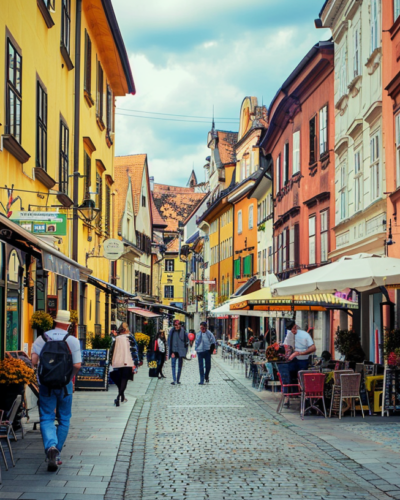Imagine stepping into the heart of Montevideo in 1930, where the very first FIFA World Cup match set the stage for what would become the globe’s most celebrated sporting spectacle. From the historic Estadio Centenario to the architectural wonders of the modern era, join us on a journey through FIFA World Cup cities that have shaped the legacy of the league.
The FIFA World Cup is more than just a global sporting event; it’s a mosaic of cultures, architectures, and histories coming together under the banner of football. Every four years, cities around the world transform into pulsating hubs of excitement, showcasing not only their capacity to host the game but also their unique contributions to its rich legacy.
Did you know that the Estadio Centenario in Montevideo, constructed specifically for the 1930 World Cup, was declared a Monument of World Football by FIFA? This is a testament to these venues’ enduring influence on the sport. As we delve into the evolution of FIFA World Cup cities, from the inaugural tournament in Uruguay to the futuristic stadiums of today, we uncover stories of triumph, transformation, and the unifying power of football that transcends borders and cultures, drawing in millions of fans from every corner of the planet.
1930 Montevideo: Marvels At The First FIFA World Cup City
When the first whistle blew in Montevideo in 1930, history was in the making. The Estadio Centenario, an architectural feat of its time, stood as a beacon of football’s new era as the city hosted the inaugural FIFA World Cup. This monumental event not only put Uruguay on the sporting map but also set a precedent for how the beautiful game would unite nations. With its colossal capacity and classical design, the stadium remains a pilgrimage site for football aficionados, embodying the spirit of competition and camaraderie that the World Cup fosters.
Beyond the bricks and mortar of the Estadio Centenario, Montevideo’s streets buzzed with anticipation as locals and visitors alike were drawn into the communal spirit of the world’s first football spectacle. This Uruguayan city not only hosted matches but became a living museum of football’s early days, where the legacy of the game’s pioneers is celebrated in every cafe, plaza, and alleyway, offering a timeless journey for those who wish to experience the genesis of the World Cup’s grandeur.
From Fascism to Fanfare: The World Cup’s Political Pitch
The FIFA World Cup cities’ collective journey through the 20th century is intertwined with the political landscapes of its host nations. In 1934 under Mussolini’s regime, Italy showcased the tournament as a symbol of fascist strength, turning stadiums into stages for propaganda. Yet, the event transcended these intentions, celebrating instead the universal language of football.
As decades passed, the World Cup became a platform for countries to emerge from political shadows, like Argentina in 1978, blending the lines between sport and statecraft and showcasing the game’s power to heal and unite.
Years after the World Cup served as a backdrop for political agendas, the tournament emerged as a beacon of hope and unity, transcending its earlier associations. Cities that once echoed with the roar of dictatorial propaganda later resonated with cheers of freedom and solidarity. This shift underscores the FIFA World Cup cities’ ability to outlive and outshine the shadows cast by its political past, reaffirming the sport’s role as a global unifier.
Stadiums of the Future: Architectural Wonders of the Game
As we ventured into the 21st century, the World Cup’s architectural landscape transformed dramatically. Stadiums became more than just venues; they were futuristic landmarks, pushing the boundaries of design and technology. Though not a FIFA World Cup city venue, the Bird’s Nest in Beijing inspired a wave of innovative stadium designs seen in structures like the Fisht Olympic Stadium in Sochi and the Allianz Arena in Munich. These venues epitomize the evolution of sports architecture, offering fans a glimpse into the future while honoring the game’s heritage.
The awe-inspiring stadiums of recent World Cup events are not just venues for matches but monuments to human creativity and engineering prowess. These coliseums are designed with sustainability and legacy in mind, ensuring they serve the host cities long after the final match.
From solar-powered arenas to rainwater recycling systems, they embody the future of eco-conscious entertainment, making each tournament showcase innovation as much as athleticism.
Beyond the Game: FIFA World Cup Cities’ Cultural Triumphs
The impact of the World Cup extends far beyond the final whistle. FIFA World Cup cities like Rio de Janeiro and Johannesburg have harnessed the tournament‘s global spotlight to showcase their rich cultures, landscapes, and histories. The event becomes a catalyst for urban renewal, inspiring projects that rejuvenate neighborhoods and infrastructure, leaving a lasting legacy that benefits residents and visitors alike. It’s a celebration of diversity, where the host city’s identity is woven into the fabric of the tournament, creating a tapestry of memories that resonate long after the crowds have dispersed.
The World Cup leaves an indelible mark on the cultural fabric of its host cities, igniting a global exchange of traditions, cuisines, and art. Long after the fans have gone, the spirit of international camaraderie lingers in the bustling markets, vibrant street art, and enriched community programs, painting a vivid picture of the world coming together in celebration of diversity and shared passions.
Legacy of the Legends: How FIFA World Cup Cities Transformed
The true testament to a World Cup city lies in its legacy— how it leverages the global stage to herald a new chapter in its history. Cities like Barcelona, which hosted the Olympics and continues to share the spirit of a transformation akin to World Cup hosts, have seen how such events can catalyze change, driving tourism, enhancing public facilities, and elevating their global profile. The World Cup is more than just a tournament; it’s an opportunity for cities to dream big, embracing the promise of renewal and the enduring spirit of the game.
The transformation witnessed in FIFA World Cup cities is a testament to the enduring impact of hosting the world’s most-watched sporting event. These cities become symbols of possibility, and the tournament’s legacy inspires future generations. From revamped public spaces to international recognition, the World Cup underscores goals for development, showcasing the host city’s culture, resilience, and spirit on the world stage long after the closing ceremonies.
FIFA World Cup Cities’ Unifying Legacy
Revisiting the essence of our journey from the historic streets of Montevideo to the innovative arenas of the 21st century, these FIFA World Cup city venues stand as testaments to the power of football in bridging cultures, inspiring architectural marvels, and transforming cities. With its unique narrative, each host city contributes to the rich tapestry of the tournament’s legacy, weaving together tales of triumph, unity, and innovation.
As we review these global celebrations of sport and culture, we’re reminded of the enduring impact of the FIFA World Cup on cities and people across continents. Let this be a call to action for fans and travelers alike: to explore these iconic cities, to walk in the footsteps of legends, and to immerse oneself in the indelible spirit of the World Cup.








